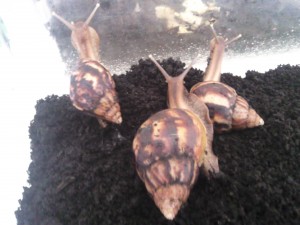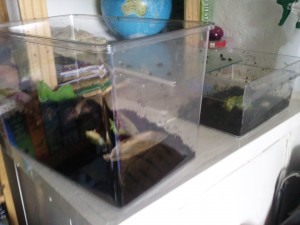Giant Land Snails As Pets
 Giant Land Snails, particularly the African Species, but also a few of the American species are often popular choices for pets, especially childrens’ pets. So why do many people choose to keep one of these snails over other animals, such as dogs, cats and rabbits?
Giant Land Snails, particularly the African Species, but also a few of the American species are often popular choices for pets, especially childrens’ pets. So why do many people choose to keep one of these snails over other animals, such as dogs, cats and rabbits?
Well, the main attraction to giant land snails as pets is that they are easy to look after – there’s no taking them for walks or such exercise involved with keeping snails and you can keep them where ever you live, countryside or town provided they are legal to keep where you live. Because giant land snails are regarded as a ‘highly invasive species’ many countries have made it illegal to keep them as pets in certain areas for fear some will get into the wild. I believe it to be illegal world wide to release these snails or their eggs into the wild – whether it is intentional or not.
Different species need to be kept in different temperatures. The most common giant african land snail species found in pet shops, Achatina Fulica, needs to be kept at around 20 °C – 28 °C and definately not exceeding 29 °C. From 2 °C – 10 °C this species is likely to go into hibernation. So, if you are thinking about aquirring a giant land snail do some reseach first! Another thing to remember is that these different species grow to different lenghts, so you will need to buy a vivarium that is the right size for that species. Achatina Fulica can grow a shell that is up to 25cm long! Before you get your snail you will also need to purchase a heat source for the winter, (a light is not necessary as they are nocturnal), substrate or medium of some sort, food and a water-mister; click here to read more about making a suitable home for your giant land snail.
 Because you can buy the necessary set up for these interesting creatures this means they can live in pratially any area where they are legal to keep. If you live in a small house with no room for many pets then why not get a giant african land snail? They take up very little room and don’t take up much of your valuable time.
Because you can buy the necessary set up for these interesting creatures this means they can live in pratially any area where they are legal to keep. If you live in a small house with no room for many pets then why not get a giant african land snail? They take up very little room and don’t take up much of your valuable time.
Be aware that if you get more than one snail your giant land snails are likely to start breeding as they are hermathrodites and any two are likely to be able to breed. Make sure you have thought about arrangements for the eggs – it is illegal to release them into the environment.
Giant Land Snails are exotic species, many from Africa (but also America). This is another reason why they are popular pets as ‘exotic animals’ sounds so much more appealing than ‘native animals’ to so many people.
Unlike many other pets giant land snials are cheap. Ok, the equipment you need may not be but the actual animals range from about £0.20 to £20 depending on the specimen. Indeed I only paid £0.40 each for my giant land snails! There are other expenses as well to keep in mind apart from the vivarium and heating: the substrate, food and water and calcium supplements.
Giant land snails are great pets for many people who have allergies to cats, dogs and other mammals. Many people who have given up hope of owning their own pet have been delighted to find they can own these amazing snails, many of whom love being handled and stroked. So giant land snails really do make excellent pets for people who have animal allergies.
Many childrens’ first pets are giant land snails as they teach children about responsibilty before they go onto getting bigger animals. But don’t be fooled! Giant land snails still need regular, quality care and require commitment – after all many exceed 10 years of age.
 August 12, 2010
·
August 12, 2010
·  Maddia (Admin) ·
Maddia (Admin) ·  3 Comments
3 Comments
 Tags: giant african land snail species, giant land snail species, giant land snails as pets · Posted in: Giant Land Snail Care, Giant Land Snail Information
Tags: giant african land snail species, giant land snail species, giant land snails as pets · Posted in: Giant Land Snail Care, Giant Land Snail Information



3 Responses
Concerned about my regular land snails (2) They have been in estivation for a month with only tiny forays out of shells to perhaps eat a tiny bit and walk a tiny bit. The older snail approx 1 year, is so far into his shell I can hardly see him. This does not seem normal Before estivation they had quite a vigorous relationship.Can they just be worn out? How can they go along for a month without eating and drinking? In prior times they were going all over their terrarium and just resting occasionally. Now I almost never see any movement. Please advise…….
Hi Jane,
Estivation in giant land snails can be a common problem if the environment they are in is too hot for them, this is likely to be the same for regular land snails too – though I’m not 100% certain without knowing what species; therefor I can not be that specific about what you should do.
Estivation is similar to hibernation, both of which occur if the temperature is wrong.
How much water are your snails getting? If you pick up the snail (and he/she isn’t in their shell) see if you can feel how soft his/her body is – a hard, waxy body can mean the snail is dehydrated. Different species require different amounts; the best way to provide them with this is to mist the tank with a water sprayer everyday. If you provide a shallow bowl of water their is a risk of the snails drowning.
The best way to bring giant land snails out of hibernation or estivation is to spray their shells directly and or run a wet finger over the opening of the shell (particularly if a membrane has formed). This may or may not work for regular land snails.
A lot of snail species are nocturnal, so you may not see a lot of them in the day time, but they should be coming out at night.
Sometimes estivation in snails can be triggered by a change or attack, e.g an attack from flies or insects in the substrate. Some owners have found that by changing the position of their snails’ tank/vivarium/terrarium can upset the snails.
Snails, Giant land snails in particular, need a calcium source (cuttlefish bone, crushed egg shells) to help them maintain a healthy shell. If they aren’t getting enough calcium or are getting it from a new source it is possible it could have triggered estivation.
If you are very worried see if there is a vet who is trained in mollusc care and see if they can offer any advice.
Hope this has helped.
Helpful blog, bookmarked the website with hopes to read more!